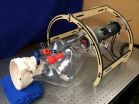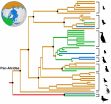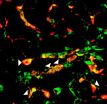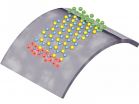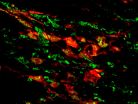(Press-News.org) For those most severely affected, treating epilepsy means drilling through the skull deep into the brain to destroy the small area where the seizures originate – invasive, dangerous and with a long recovery period.
Five years ago, a team of Vanderbilt engineers wondered: Is it possible to address epileptic seizures in a less invasive way? They decided it would be possible. Because the area of the brain involved is the hippocampus, which is located at the bottom of the brain, they could develop a robotic device that pokes through the cheek and enters the brain from underneath which avoids having to drill through the skull and is much closer to the target area.
To do so, however, meant developing a shape-memory alloy needle that can be precisely steered along a curving path and a robotic platform that can operate inside the powerful magnetic field created by an MRI scanner.
The engineers have developed a working prototype, which was unveiled in a live demonstration this week at the Fluid Power Innovation and Research Conference in Nashville by David Comber, the graduate student in mechanical engineering who did much of the design work.
The business end of the device is a 1.14 mm nickel-titanium needle that operates like a mechanical pencil, with concentric tubes, some of which are curved, that allow the tip to follow a curved path into the brain. (Unlike many common metals, nickel-titanium is compatible with MRIs.) Using compressed air, a robotic platform controllably steers and advances the needle segments a millimeter at a time.
According to Comber, they have measured the accuracy of the system in the lab and found that it is better than 1.18 mm, which is considered sufficient for such an operation. In addition, the needle is inserted in tiny, millimeter steps so the surgeon can track its position by taking successive MRI scans.
According to Associate Professor of Mechanical Engineering Eric Barth, who headed the project, the next stage in the surgical robot's development is testing it with cadavers. He estimates it could be in operating rooms within the next decade.
To come up with the design, the team began with capabilities that they already had.
"I've done a lot of work in my career on the control of pneumatic systems," Barth said. "We knew we had this ability to have a robot in the MRI scanner, doing something in a way that other robots could not. Then we thought, 'What can we do that would have the highest impact?'"
At the same time, Associate Professor of Mechanical Engineering Robert Webster had developed a system of steerable surgical needles. "The idea for this came about when Eric and I were talking in the hallway one day and we figured that his expertise in pneumatics was perfect for the MRI environment and could be combined with the steerable needles I'd been working on," said Webster.
The engineers identified epilepsy surgery as an ideal, high-impact application through discussions with Associate Professor of Neurological Surgery Joseph Neimat. They learned that currently neuroscientists use the through-the-cheek approach to implant electrodes in the brain to track brain activity and identify the location where the epileptic fits originate. But the straight needles they use can't reach the source region, so they must drill through the skull and insert the needle used to destroy the misbehaving neurons through the top of the head.
Comber and Barth shadowed Neimat through brain surgeries to understand how their device would work in practice.
"The systems we have now that let us introduce probes into the brain – they deal with straight lines and are only manually guided," Neimat said. "To have a system with a curved needle and unlimited access would make surgeries minimally invasive. We could do a dramatic surgery with nothing more than a needle stick to the cheek."
The engineers have designed the system so that much of it can be made using 3-D printing in order to keep the price low. This was achieved by collaborating with Jonathon Slightam and Vito Gervasi at the Milwaukee School of Engineering who specialize in novel applications for additive manufacturing.
INFORMATION:
Current funding comes through grant 0540834 from the Center for Compact and Efficient Fluid Power, a National Science Foundation Engineering Research Center that supports advances in fluid power, and past funding from Martin Ventures.
Visit Research News @ Vanderbilt for more research news from Vanderbilt. [Media Note: Vanderbilt has a 24/7 TV and radio studio with a dedicated fiber optic line and ISDN line. Use of the TV studio with Vanderbilt experts is free, except for reserving fiber time.]
Having had children – particularly early in life – and a dysfunctional romantic relationship are the two most frequently cited reasons when low-income mothers are asked about why they find themselves in poverty. So say American researchers Kristin Mickelson of the School of Social and Behavioral Sciences at Arizona State University, and Emily Hazlett of Kent State University and the Northeast Ohio Medical University, in a new article published in Springer's journal Sex Roles. The researchers believe that how a woman answers the question of "why me?" when thinking ...
Modern-day puffins and auks have long been recognized as environmental indicator species for ongoing faunal shifts, and fossil records now indicate that ancient relatives were similarly informative. Researchers have found that puffins and auks may have been at their most diverse and widespread levels during a relatively warm period of Earth's history. The results also explain how past extinctions have shaped the geographic distribution and population size of existing species.
Authors Adam Smith of the National Evolutionary Synthesis Center (NESCent) in Durham, N.C., and ...
COLLEGE PARK, Md. – A new analysis of global energy use, economics and the climate shows that without new climate policies, expanding the current bounty of inexpensive natural gas alone would not slow the growth of global greenhouse gas emissions worldwide over the long term, according to a study appearing today in Nature.
Because natural gas emits half the carbon dioxide of coal, many people hoped the recent natural gas boom could help slow climate change—and according to government analyses, natural gas did contribute partially to a decline in U.S. carbon ...
This market effect erases the advantage of lower emissions from the natural gas itself, according to an unprecedented international comparison of computer simulations.
"The upshot is that abundant natural gas alone will not rescue us from climate change," says the lead author Haewon McJeon of the Department of Energy's Pacific Northwest National Laboratory (PNNL). Especially in the US advances such as hydraulic fracturing – pumping liquids into stone to break it up and release the gas, known as fracking – and horizontal drilling have led to bountiful natural ...
UCLA researchers have discovered that some scar-forming cells in the heart, known as fibroblasts, have the ability to become endothelial cells — the cells that form blood vessels. The finding could point the way toward a new strategy for treating people who have suffered a heart attack, because increasing the number of blood vessels in the heart boosts its ability to heal after injury.
In studies involving mice, the UCLA team also found that a drug could enhance this phenomenon and improve the repair process after a heart attack.
The research is published in the ...
New York, NY—October 15, 2014—Researchers from Columbia Engineering and the Georgia Institute of Technology report today that they have made the first experimental observation of piezoelectricity and the piezotronic effect in an atomically thin material, molybdenum disulfide (MoS2), resulting in a unique electric generator and mechanosensation devices that are optically transparent, extremely light, and very bendable and stretchable.
In a paper published online October 15, 2014, in Nature, research groups from the two institutions demonstrate the mechanical ...
CHAPEL HILL – Researchers from the UNC School of Medicine have discovered that cells called fibroblasts, which normally give rise to scar tissue after a heart attack, can be turned into endothelial cells, which generate blood vessels to supply oxygen and nutrients to the injured regions of the heart, thus greatly reducing the damage done following heart attack.
This switch is driven by p53, the well-documented tumor-suppressing protein. The UNC researchers showed that increasing the level of p53 in scar-forming cells significantly reduced scarring and improved heart ...
Removing a child's tonsils is one of the most common surgeries performed in the United States, with approximately 500,000 children undergoing the procedure each year. New research finds that children from lower-income families are more likely to have complications following the surgery.
In the first study of its kind to analyze post-operative complications requiring a doctor's visit within the first 14 days after tonsillectomy, researchers saw a significant disparity based on income status, race and ethnicity.
"Surprisingly, despite all children having a relatively ...
WORCESTER, MA – An international group of scientists led by Gang Han, PhD, at the University of Massachusetts Medical School, has combined a new type of nanoparticle with an FDA-approved photodynamic therapy to effectively kill deep-set cancer cells in vivo with minimal damage to surrounding tissue and fewer side effects than chemotherapy. This promising new treatment strategy could expand the current use of photodynamic therapies to access deep-set cancer tumors.
"We are very excited at the potential for clinical practice using our enhanced red-emission nanoparticles ...
Montréal, October 15, 2014 – An important scientific breakthrough by a team of IRCM researchers led by Michel Cayouette, PhD, is being published today by The Journal of Neuroscience. The Montréal scientists discovered that a protein found in the retina plays an essential role in the function and survival of light-sensing cells that are required for vision. These findings could have a significant impact on our understanding of retinal degenerative diseases that cause blindness.
The researchers studied a process called compartmentalization, which establishes ...
